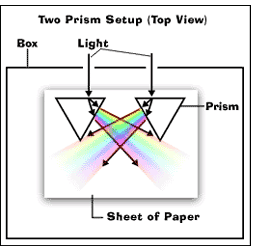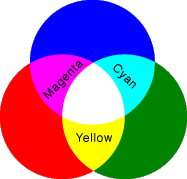|
|
|
Light rays are waves of energy, and only a small area of the electromagnetic spectrum is visible to the human eye. We can't see infrared light, or ultraviolet - only the area in between. As the size of the wave changes, so does the colour we see. |
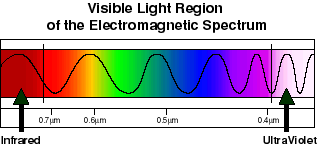 |
|
|
Light waves with the longest length look red to our eyes, then orange, and they move on up the colours of the rainbow to get to indigo and violet. ROY G BIV (a silly person's name) is an easy way to remember the colours of the rainbow in the right order. |
|
We call these colours the colours of the spectrum. You can see them in a rainbow in the sky, when light passes through raindrops, and spreads out. When all the colours are mixed together, it makes white light, but when they go through a raindrop (or a prism), each colour or wave length bends (or refracts) by a different amount. So, all the colours spread out, and you can see each one separately. |
|
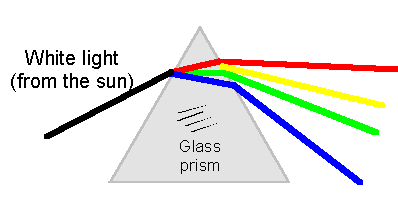 |
In this diagram, you can see that the red bends by the smallest amount, and the blue bends the most. If you then put another prism there for these separate colours to go through, you could make all the colours meet again, and the light would become white. That's because mixing all the colours together makes white. |
|
Red, blue, and green are the primary colours of light. Mixing these colors can produce all of the colours of the spectrum. Our eyes have cells in the eye that react to colours of light. Some cells react only to red. Others react to green. Still others react only to blue. If the eye is struck with equal amounts of red, blue, and green light, we see white. Yet if the eye is struck with only red and green light, we see yellow. |
|
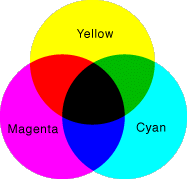 |
But when you mix all colours of paint together, it makes black! How come? Colours from mixing paints are different from the colours you get when you mix coloured lights. Magenta, cyan, and yellow are called the primary pigments. Something with any of these colours absorbs one primary colour of light and reflects the other two. So all of them together absorb all the colours, and all your eye can see is black. |

|
Look at this photo from a magazine. Each frame is magnified, so it is blown up larger and larger. By the end one, you can see how the picture is made up. It is made of lots and lots of tiny little dots. Try looking at a magazine picture with a strong magnifying glass, and this is what you will see. |

